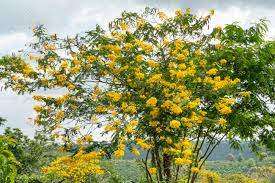Important Facts For Prelims
Senna Spectabilis
- 31 Jan 2023
- 3 min read
Why in News?
Kerala has come out with a management plan to eradicate Senna spectabilis, the exotic invasive plant that is posing a severe threat to the State’s wildlife habitat.
- The management plan stipulates that there should not be an attempt to kill the trees before a detailed reforestation programme and the resources for implementing it are in place.
What is Senna spectabilis?
- Senna spectabilis is a deciduous tree native to tropical areas of America.
- It grows up to 15 to 20 metres in a short period of time and distributes thousands of seeds after flowering.
- The thick foliage of the tree arrests the growth of other indigenous tree and grass species. Thus, it causes food shortage for the wildlife population, especially herbivores.
- It also adversely affects the germination and growth of the native species.
- It is categorised as ‘Least Concern’ under IUCN Red List.
What is the Eradication Plan?
- The plan envisages landscape-level management of the tree.
- Once the resources and material for landscape restoration are ready, the invasive species has to be removed using a threefold approach for large trees, large saplings, and small saplings.
- The large trees need to be debarked from breast height downwards (1.3 m above ground level), including the collar part of the tree. Once done, the trees should be visited once a month to remove the new growth across the debarked area.
- The larger saplings can be uprooted using specially designed weed pullers.
- The third is the removal of small plantlets which need to be removed mechanically.
- The large trees would take a minimum of 18 months to completely dry up after debarking.
What is an Invasive Species?
- An invasive species is an organism that causes ecological or economic harm in a new environment where it is not native.
- They are capable of causing extinctions of native plants and animals, reducing biodiversity, competing with native organisms for limited resources, and altering habitats.
- They can be introduced to an area by ship ballast water, accidental release, and most often, by people.
- There are many invasive species in India. For eg: Charru Mussel, Lantana bushes, Indian Bullfrog, etc.






-min.jpg)